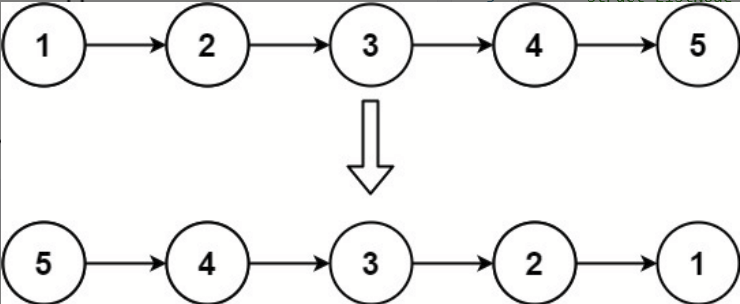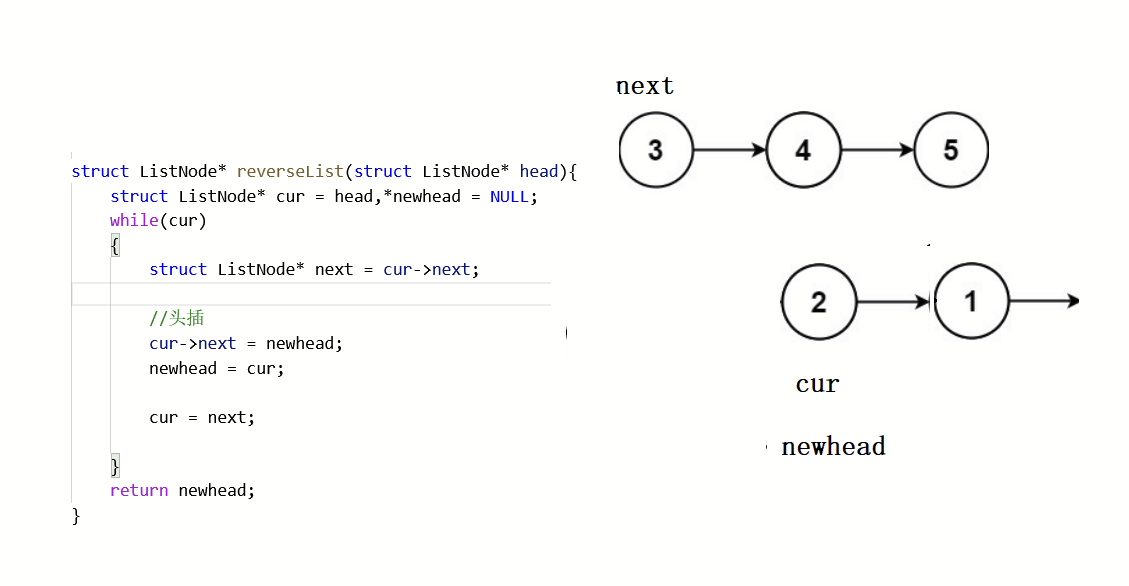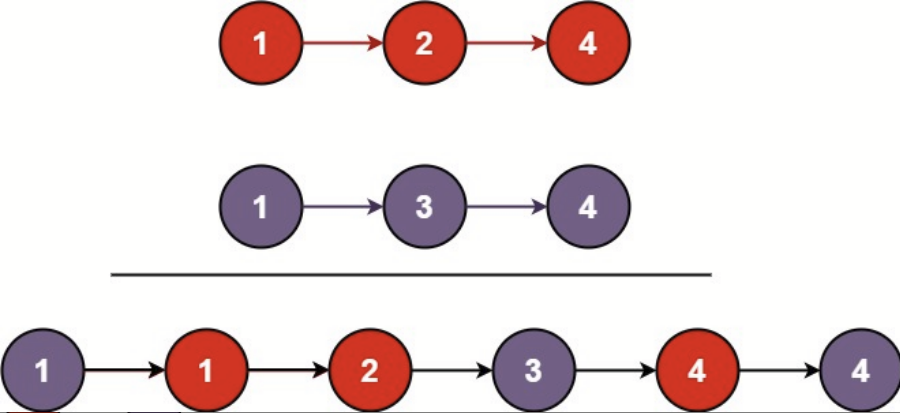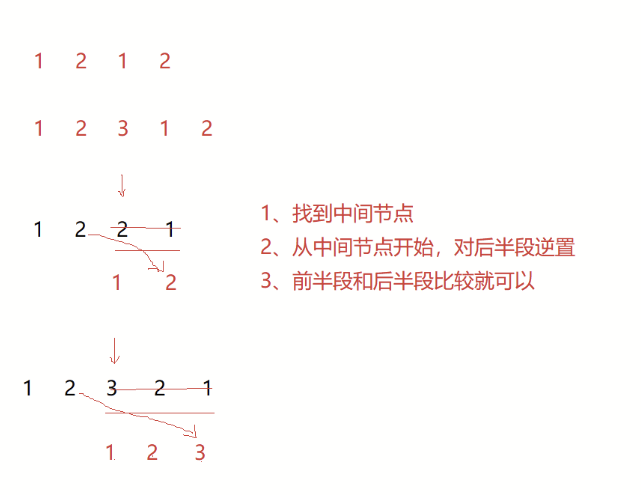
悟已往之不谏 知来者之可追
目录
 一、反转链表
一、反转链表

输入:head = [1,2,3,4,5]
输出:[5,4,3,2,1]![]()
输入:head = [1,2]
输出:[2,1]示例 3:
输入:head = []
输出:[]提示:
- 链表中节点的数目范围是
[0, 5000]-5000 <= Node.val <= 5000
方法一:
代码解析:
struct ListNode* reverseList(struct ListNode* head){
if(head == NULL)
{
return NULL;
}
struct ListNode* n1,*n2,*n3;
n1 = NULL;
n2 = head;
n3 = n2->next;
while(n2)
{
//翻转链表
n2->next = n1;
//迭代
n1 = n2;
n2 = n3;
if(n3)
n3 = n3->next;
}
return n1;
}画图解析:

注:该题使用到了三指针
方法二:
代码解析:
struct ListNode* reverseList(struct ListNode* head){
struct ListNode* cur = head,*newhead = NULL;
while(cur)
{
struct ListNode* next = cur->next;
//头插
cur->next = newhead;
newhead = cur;
cur = next;
}
return newhead;
} 画图解析:
此方法采用头插方式
 二、合并两个有序链表
二、合并两个有序链表
将两个升序链表合并为一个新的 升序 链表并返回。新链表是通过拼接给定的两个链表的所有节点组成的。
示例 1:

输入:l1 = [1,2,4], l2 = [1,3,4]
输出:[1,1,2,3,4,4]示例 2:
输入:l1 = [], l2 = []
输出:[]示例 3:
输入:l1 = [], l2 = [0]
输出:[0]提示:
两个链表的节点数目范围是 [0, 50]
-100 <= Node.val <= 100
l1 和 l2 均按 非递减顺序 排列
代码解析:
struct ListNode* mergeTwoLists(struct ListNode* list1, struct ListNode* list2){
if(list1 == NULL)
{
return list2;
}
if(list2 == NULL)
{
return list1;
}
struct ListNode* cur1 = list1,*cur2 = list2;
struct ListNode* head = NULL,*tail = NULL;
while(cur1 && cur2)
{
if(cur1->val < cur2->val)
{
if(head == NULL)
{
head = tail = cur1;
}
else
{
tail->next = cur1;
tail = tail->next;
}
cur1 = cur1->next;
}
else
{
if(head == NULL)
{
head = tail = cur2;
}
else
{
tail->next = cur2;
tail = tail->next;
}
cur2 = cur2->next;
}
}
if(cur1)
{
tail->next = cur1;
}
if(cur2)
{
tail->next = cur2;
}
return head;
}画图解析:

 三、链表分割
三、链表分割
描述
现有一链表的头指针 ListNode* pHead,给一定值x,编写一段代码将所有小于x的结点排在其余结点之前,且不能改变原来的数据顺序,返回重新排列后的链表的头指针。
思路:
小于尾插到一个链表,大于等于尾插到另一个链表,再将两个链表链接起来
代码解析:
class Partition {
public:
ListNode* partition(ListNode* pHead, int x) {
// write code here
struct ListNode* gGurad,*gTail,*lGuard,*lTail;
gGurad = gTail = (struct ListNode*)malloc(sizeof(struct ListNode));
lGuard = lTail = (struct ListNode*)malloc(sizeof(struct ListNode));
gTail->next = lTail->next = NULL;
struct ListNode* cur = pHead;
while(cur)
{
if(cur->val < x)
{
lTail->next = cur;
lTail = lTail->next;
}
else
{
gTail->next = cur;
gTail = gTail->next;
}
cur= cur->next;
}
lTail->next = gGurad->next;
gTail->next =NULL;
pHead = lGuard->next;
free(gGurad);
free(lGuard);
return pHead;
}
};画图解析:

此题我们需要用到哨兵位的头节点
 四、链表的回文结构
四、链表的回文结构
描述
对于一个链表,请设计一个时间复杂度为O(n),额外空间复杂度为O(1)的算法,判断其是否为回文结构。
给定一个链表的头指针A,请返回一个bool值,代表其是否为回文结构。保证链表长度小于等于900。
测试样例:
1->2->2->1
返回:true代码解析:
//查找中间节点
struct ListNode* Mid(struct ListNode* Head) {
struct ListNode* slow = Head;
struct ListNode* fast = Head;
while (fast && fast->next) {
slow = slow->next;
fast = fast->next->next;
}
return slow;
}
//链表逆置
struct ListNode* reverse(struct ListNode* Head)
{
struct ListNode* cur = Head;
struct ListNode* phead = NULL;
while(cur)
{
struct ListNode* next = cur->next;
cur->next = phead;
phead = cur;
cur = next;
}
return phead;
}
class PalindromeList {
public:
bool chkPalindrome(ListNode* A) {
struct ListNode* MidList = Mid(A);
struct ListNode* ReList = reverse(MidList);
struct ListNode* pphead = A;
struct ListNode* ppheadR = ReList;
while(pphead && ppheadR)
{
if(pphead->val != ppheadR->val)
{
return false;
}
else
{
pphead = pphead->next;
ppheadR = ppheadR->next;
}
}
return true;
}
};
画图解析:
